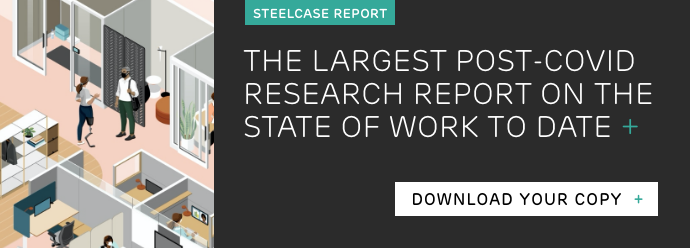Though working from home had its benefits, like more autonomy and the ability to work in our pyjamas, there’s one thing we’ve all really missed about the office: our colleagues. We’ve missed working in-person with our teams and the opportunities for chance interactions.
Now, after 18 months, more and more people are heading back to the workplace. Office occupancy rates have hit their highest levels since March 2020, according to Freespace.
But as we return, organisations must consider how they can optimise the work environment to facilitate the social connections we’ve all been craving.
Design principles for the new world of work
A new set of design principles are enabling organisations to create a better work experience for their people.
So how can we use these to create better social spaces within the workplace?
- Me + We is about equally supporting individual and team work. So when it comes to designing social spaces, there must be areas where people can focus on individual work while still being stimulated by energy and buzz.
- Fixed to Fluid refers to design for greater flexibility and mobility. In social spaces, small tables can be made available and easily moved together or apart to support people to come together or work alone as needed.
- Open + Enclosed is about needing more enclosed ‘me’ spaces and more open ‘we’ spaces. Moveable screens, for example, allow people to adapt boundaries and create added privacy as needed.
- Braiding digital + physical is about enhancing the human experience through technology. In social spaces, large-scale, mobile devices and mobile power allow teams to turn open spaces into settings where they can move work forward on demand.
Social spaces - ideas to inspire
1. The informal lounge

Within this setting, acoustic panels on the walls provide acoustic privacy and lessen the ambient sounds of adjacent spaces, allowing workers to host informal conversations in a relaxed environment. Truchet Acoustic Tiles are ideal for open-plan settings and can be wall-mounted or hung from the ceiling. They absorb an average of 90% of all soundwaves, and have been designed to look as good as they perform. Comfortable armchairs help workers to feel relaxed while side tables and personal tables on wheels can be easily moved around as needed.
2. A sheltered space for two
 In this setting, two colleagues can come together to share ideas or have lunch in a casual environment. Armchairs help workers to feel relaxed and there’s plenty of space to set laptops, notebooks and other tools. The Lagunitas personal table can be pulled up close to provide a comfortable work experience. The multifunctional X-Stool by Bolia can be used as a side table or stool, enabling an additional colleague to stop by briefly and join the conversation. And the mobile stand from the Steelcase Roam Collection can be rolled in to facilitate brainstorming or to bring remote colleagues into the conversation.
In this setting, two colleagues can come together to share ideas or have lunch in a casual environment. Armchairs help workers to feel relaxed and there’s plenty of space to set laptops, notebooks and other tools. The Lagunitas personal table can be pulled up close to provide a comfortable work experience. The multifunctional X-Stool by Bolia can be used as a side table or stool, enabling an additional colleague to stop by briefly and join the conversation. And the mobile stand from the Steelcase Roam Collection can be rolled in to facilitate brainstorming or to bring remote colleagues into the conversation.
3. The multimodal space

This social setting supports multiple modes of work for individuals or small groups. A mix of seating and table arrangements support different postures and preferences, while dividers provide privacy from adjacent spaces without workers feeling cut off. For example, the Sticks Divider by Extremix can be positioned at a range of angles, from straight line to wavy line or even a full circle to provide privacy.
4. The community hub

This social space supports multiple work modes, including socialising, brainstorming and serendipitous exchanges. Comfortable, informal furniture creates a living room-like space that creates authentic experiences. Benches and stools can be pulled around a whiteboard, chairs designed for lounging create a space to chat one on one, while high tables with stools provide a space to work while still feeling a part of the community.
5. The cosy dyad

This setting is designed to support one-on-one conversations. Colleagues can get together for a casual catch up, to eat lunch, or work alone together. The seating allows for eye contact and the addition of side tables and access to power make work easy.
Planning for performance
The casual atmosphere of social spaces is what often draws us in, but these spaces must also support us to work in the way we want. We need spaces that provide some level of privacy, whether visual or acoustic. We need spaces with surfaces for technology and access to power. We need spaces that support the posture for the task at hand, whether lounging, task, stool-height or standing.
And it’s hard to have good social interactions when we don’t feel comfortable, so we need spaces that provide a sense of psychological comfort, where people feel relaxed and at ease. Think comfortable armchairs, with acoustic screens for privacy and personal tables and power so people have the tools they need to get work done.
Summary
Work is a social activity, and we’ve missed being with our colleagues in-person. Offices will need to facilitate these social connections to ensure workers are engaged and energised, especially where a hybrid work model means employees may only be in the office two or three times a week.
Ultimately, some of the best ideas happen away from the desk, outside of meeting rooms and in more relaxed, informal settings where workers can communicate more casually. Social spaces that support these interactions are a win-win for both employee happiness and business performance.









